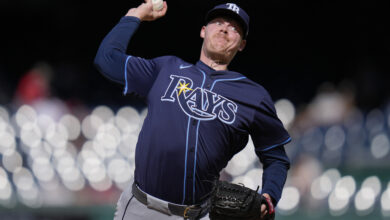Why Trade for an Ace?
If you missed last night’s twitter debacle, in which Cubs Insider’s Fearless Leader made up a bunch of lies and said Jordan Zimmermann to the Cubs was a done deal*, you may have missed a really interesting split among Cubs fans. Some were ecstatic at the idea of acquiring Zimmermann, a legit #1 who will be just 29 next season, while others were a bit more reserved.
As the headline probably tipped you off, I’m squarely in the latter camp. While there’s no question that Zimmermann is an excellent pitcher who would immediately improve this Cubs team, any package for him would be painful. If Zimmermann were traded to the Cubs, he’d certainly come with a 5-6 year extension in tow, and that combo is necessarily going to require a high prospect cost.
A sign-and-trade could be desirable if Zimmermann’s contract ended up being below-market, but seeing as he’s only a year away from free agency I just don’t see him taking a big discount. Why would he?
But regardless of what the specifics of a Zimmermann deal would look like, or a what a Hamels trade would look like, I find myself unable to justify trading away young talent for an expensive pitcher in this climate.
Currently, there are two legitimate #1 pitchers available for money only in Jon Lester and Max Scherzer. After the 2015 season, David Price is likely to enter the free agent market (as will Zimmermann if he is not locked up long-term). That’s three great pitchers available for only cash, albeit a lot of it.
Just below the Lester-Scherzer-Price-Zimmermann tier, the following pitchers are either available this season or are likely to be available after next season: Johnny Cueto, Jeff Samardzija, James Shields, Doug Fister, Hisashi Iwakuma, Mat Latos, Ervin Santana, Francisco Liriano, Wei-Yin Chen, Brandon McCarthy, Justin Masterson.
That’s a boatload of attractive rotation options that might be available in free agency over the next 15 months. Sure, some will sign extensions. But even then there is a lot of free agent pitching to be had.
In that light…why trade for an ace?
It’s a Rare Opportunity?
Well, considering the amount of free agent pitching available in the next few seasons, I don’t think it is. Zimmermann’s great, but he already has one Tommy John surgery on his resume and is not clearly better than Lester or Scherzer.
The argument always goes, “There’s no guarantee you can sign one of those guys,” but elite free agents often seem to be swayed by one thing only – money. There are many free agent pitchers available and the Cubs should, hopefully, have the money to persuade them. By trading for one now, instead of spending on the big guys, you’re just trading away good talent for the right to give a guy $150 million.
Surplus Value?
Sure, I guess it’s possible that the extension the Cubs sign Zimmermann to could be below-market. Say you get Zimmermann on a deal that’s $30 million cheaper than the premiere free agents. Is that worth a Castro/Baez/Russell? Well, it depends on how you fill the hole you create by trading them away.
Theoretically, the benefit of surplus value is affording the team the chance to spend that money elsewhere. This theory was more useful half a decade ago before teams started signing good players to long-term extensions. The free agent pool was much deeper back then and you could more easily find suitable replacements for traded players.
Baseball is no longer like that.
If you acquire a player with $30 million in total surplus value, who are you spending those savings on? The free agent market is virtually devoid of big-time bats, and that trend doesn’t change any time soon. Considering the Cubs would be moving bats for a pitcher, the surplus value likely can’t be spent to fill the holes a trade creates**. Given the scarcity of bats, holding on to young hitters and paying for pitching is probably an easier route to pursue.
They’re the Cubs
I hate to sound so meatball-y, but here we go…if you found yourself shouting, “they could throw that extra $30 million at McCarthy, or sweeten Martin’s deal,” I think it implies that the Cubs couldn’t find that money somewhere else. I just can’t bring myself to accept that the Cubs are that poor.
Given the new incoming revenue streams, a $400 million sale of a 20% stake in the team, better-than-expected attendance figures, and a rock-bottom 2015 payroll, the Cubs should easily be able to sign a big-time pitcher, Martin, and McCarthy in one offseason. They should also be able to turn right around and sign another big-time pitcher next offseason.
If the revenue streams (especially from the media rights side of things) have not grown to the point to allow a payroll of – gasp! – $110-$120 million by 2016, the business side of the team has failed horribly. If the team is so stretched that ownership couldn’t find the (maybe!) $6 or $7 million per year a Zimmermann sign-and-trade would save them, the organization is in serious trouble.
If revenue sources develop as the team expects, though, I cannot understand trading good young talent for a soon-to-be very expensive pitcher. Good thing it’s probably not happening.
*Just kidding, Tom
**I’m going to get some flack for this, but the Cubs do not have a demonstrated surplus of anything to trade from right now. There’s only one young middle infielder in the org who has shown the ability to hit major league pitching, play shortstop, and stay healthy. As Sahadev Sharma has told me many times, “you need to trust that the org can self-scout well enough to keep the right guys,” but given the general unpredictability of prospects I don’t know if I trust any front office to be perfect in their self-scouting.

